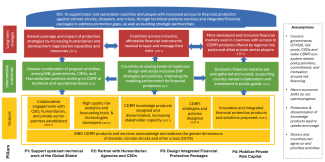Demystifying the Monitoring, Evaluation, and Learning Framework
By supporting the design and implementation of innovative risk financing solutions, GSFF investments present a tremendous learning opportunity for vulnerable countries in disaster and crisis risk finance. GSFF invests in projects across different geographic, economic, and political contexts, providing ample options for cross-project learning. The Monitoring, Evaluation, and Learning (MEL) team has established a rigorous but flexible MEL framework to support learning and measure the GSFF initiative's success.
Figure 1: GSFF Monitoring and Evaluation Framework Components

The framework's foundation is the GSFF theory of change (TOC), which lays out the conceptual framework on how GSFF investments will bring about positive change (Figure 2).
Figure 2: GSFF Theory of Change
To support the reporting of results, the monitoring component of the framework covers regular annual reporting, including key indicators. The evaluation component consists of formal impact or process evaluations required by trust fund rules and more demand-driven and targeted case studies exploring a specific aspect of DRF related to GSFF-supported projects.
As part of GSFF, we want to capture better these challenges and how task teams and their counterparts overcome them to successfully place instruments to protect governments, firms, and households. We produce short learning briefs from case studies that cater to internal and external audiences to promote adaptive learning. The learning component will link closely with the GSFF Communication team to ensure our findings and lessons learned reach various stakeholders.

